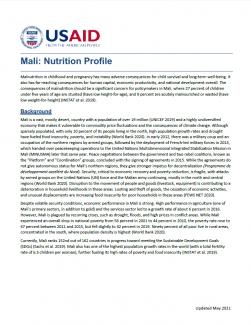Mali is a vast, mostly desert, country with a population of over 19 million (UNICEF 2019) and a highly undiversified economy that makes it vulnerable to commodity price fluctuations and the consequences of climate change. Although sparsely populated, with only 10 percent of its people living in the north, high population growth rates and drought have fueled food insecurity, poverty, and instability (World Bank 2020). In early 2012, there was a military coup and an occupation of the northern regions by armed groups, followed by the deployment of French-led military forces in 2013, which handed over peacekeeping operations to the United Nations Multidimensional Integrated Stabilization Mission in Mali (MINUSMA) later that same year. Peace negotiations between the government and two rebel coalitions, known as the “Platform” and “Coordination” groups, concluded with the signing of agreements in 2015. While the agreements do not give autonomous status for Mali’s northern regions, they give stronger impetus for decentralization (Programme de développement accéléré du Nord). Security, critical to economic recovery and poverty reduction, is fragile, with attacks by armed groups on the United Nations (UN) force and the Malian army continuing, mostly in the north and central regions (World Bank 2020). Disruption to the movement of people and goods (livestock, equipment) is contributing to a deterioration in household livelihoods in these areas. Looting and theft of goods, the cessation of economic activities, and unusual displacements are increasing food insecurity for poor households in these areas (FEWS NET 2020).
Despite volatile security conditions, economic performance in Mali is strong. High performance in agriculture (one of Mali’s primary sectors, in addition to gold) and the services sector led to a growth rate of about 6 percent in 2016. However, Mali is plagued by recurring crises, such as drought, floods, and high prices in conflict areas. While Mali experienced an overall drop in national poverty from 56 percent in 2001 to 44 percent in 2010, the poverty rate rose to 47 percent between 2011 and 2015, but fell slightly to 42 percent in 2019. Ninety percent of all poor live in rural areas, concentrated in the south, where population density is highest (World Bank 2020).
Currently, Mali ranks 152nd out of 162 countries in progress toward meeting the Sustainable Development Goals (SDGs) (Sachs et al. 2019). Mali also has one of the highest population growth rates in the world (with a total fertility rate of 6.3 children per woman), further fueling its high rates of poverty and food insecurity (INSTAT et al. 2019).

